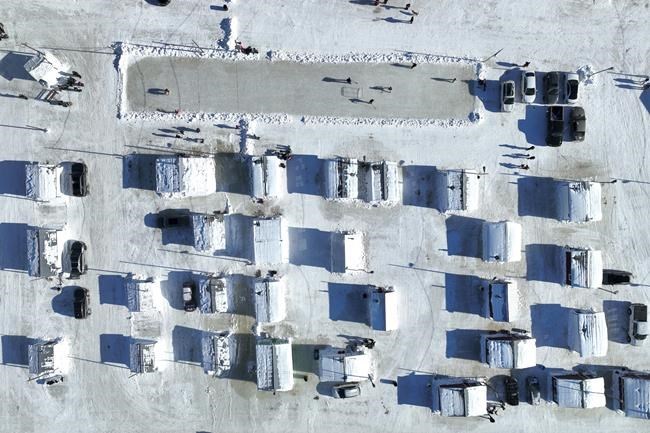
An overall view of some the more than 350 ice fishing cabins on the Ste-Anne River in Sainte-Anne-de-la-Pérade, Que., on January 15, 2023. THE CANADIAN PRESS/Bernard Brault
February 16, 2025 - 3:00 AM
MONTREAL - Olivier Soumis’s green canvas tent sits in the middle of the frozen St. Lawrence River, providing a stark pop of colour against the muted tones of the snow and the open water in the distance. While thousands of people are heading to work just across the river in Montreal, the 25-year-old is out fishing.
As the sky turns from pink to grey, the end of his pole dips and he begins pulling fish from the hole in the ice. First a couple of walleye that are too small to keep are unhooked and quickly slid back into the water. Another, bigger walleye isn’t so lucky and gets tossed into a plastic sled for a later meal.
A year after warm temperatures severely curtailed many of Quebec’s winter activities, the return of real winter weather has been a boon for ice fishers like Soumis, who are able to explore frozen waterways that have been off limits in recent years — even as they wonder how long it will last.
“This year is like it was 10 years ago,” he told The Canadian Press in an interview that was regularly interrupted by fish on the line. “The old-timers who have been fishing for a long time always say, ‘We used to be able to go this place and that place in a car.’ Well, this year it’s like that,” he said.
Soumis has been venturing out to fish on frozen lakes since he was a young child. In recent years, he’s started a guiding company, Soumis Aventure, that takes tourists and locals out on the ice.
He said he's been seeing more people out fishing around Montreal this winter. When the ice is thick, people can bring out heated tents or even cabins, along with beer, speakers and barbecues to fry up an al fresco fish lunch, he said.
But as he basks in the cold, he wonders how many more winters he’ll be able to fish with the Montreal skyline as a backdrop. “Sometimes we joke that in 10 years we’re going to be on a small ice block in the middle of the river,” he said.
Gina Ressler, a meteorologist from Environment Canada, said that while this winter isn't cold by historical standards in Quebec, it feels that way compared to last year, when an El Nino pattern brought warmer temperatures. "Once winter did arrive in January, it’s kind of been here to stay," she said.
Montreal isn’t the only place celebrating the cold. About 200 kilometres north of Quebec City, hundreds of colourful huts will once again be dotting the fiord at a pair of ice-fishing villages near Saguenay, Que., after last year’s warm weather forced authorities to cancel the popular tradition for the first time ever.
Last year’s cancellation was a big blow to local fishers and tourist outfitters, according to Marilou Tremblay, who works for Contact Nature, the group that manages the event. This year, the return of the ice village, as well as the first winter cruise ship arrivals in the region, have people feeling "pretty positive," she said.
With up to 1,200 huts at Anse-à-Benjamin and Grande-Baie, the fishing villages are among the biggest in the world and create an “absolutely magical landscape,” she said. “We see the mountains of the fiord in the distance and the ships in the navigable channel between the two villages. It’s almost hard to believe if you haven’t seen it."
While this season has been promising, both Soumis and Tremblay are aware that temperatures in recent years have been trending warmer, forcing seasons to begin later and end earlier and forcing the fishing world to adapt.
Tremblay said a regional consultation is bringing together anglers, businesses, outfitters and biologists to reflect on the future of ice fishing. More and more, people are switching to lighter cabins that don’t need as much heavy equipment to install, or using tents to fish solo. While a person can fish on as little as 10 centimetres of ice, lighter cabins require 30 cm and heavier ones require 45 cm.
This year, her organization also launched an app, Glaces du Fjord, which includes a map of the area with ice thickness markings, as well as information such as parking lots and entrances.
“It’s really to improve the safety aspect, which will become more and more an issue with people who will be fishing outside the village,” she said.
Back in Montreal, Soumis says he’s also noticing changes. More and more, fishing huts and cabins are being replaced by tents, and cars and snow machines are being replaced by people pulling equipment on light sleds like the one he uses. Heavier ice-borer drills that are suited to two or three feet of ice are increasingly giving way to less-powerful, lighter, battery-operated ones.
Despite warm temperatures in recent winters, Soumis said he’s always been able to find places to fish. However, he had to stay closer to shore, away from the current where some species of fish are more plentiful. He has also cut short his March fishing, which is normally his favourite season.
His plan, he said, is to move further north in a few years, towards colder winters and thicker ice. But for now, he’s enjoying what the cold weather brings to his line.
This report by The Canadian Press was first published Feb. 16, 2025.
News from © The Canadian Press, 2025